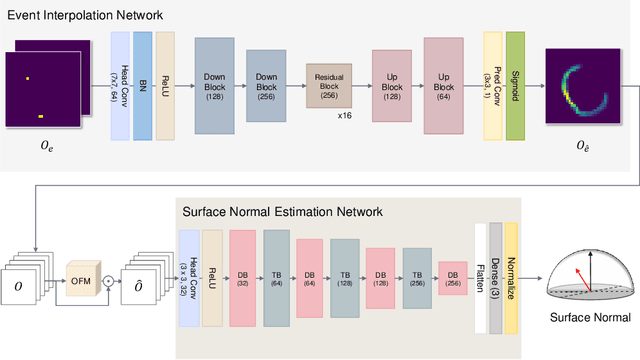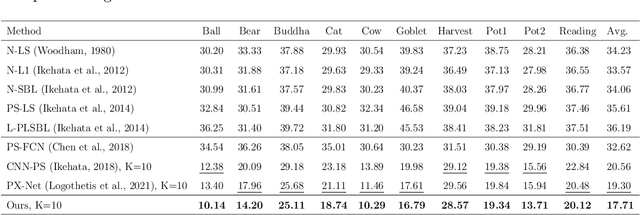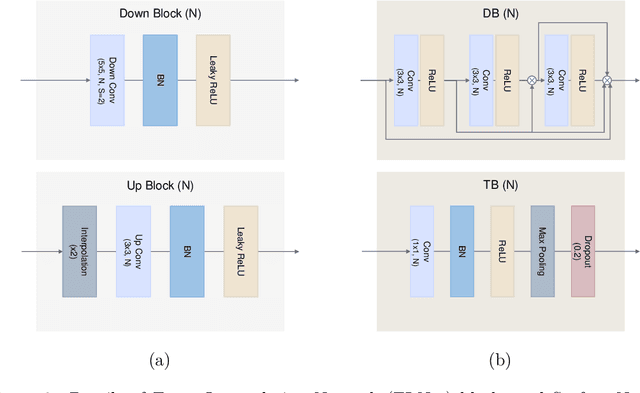Jae-Sang Hyun
Quasi-calibration method for structured light system with auxiliary camera
Mar 02, 2024Abstract:The structured light projection technique is a representative active method for 3-D reconstruction, but many researchers face challenges with the intricate projector calibration process. To address this complexity, we employs an additional camera, temporarily referred to as the auxiliary camera, to eliminate the need for projector calibration. The auxiliary camera aids in constructing rational model equations, enabling the generation of world coordinates based on absolute phase information. Once calibration is complete, the auxiliary camera can be removed, mitigating occlusion issues and allowing the system to maintain its compact single-camera, single-projector design. Our approach not only resolves the common problem of calibrating projectors in digital fringe projection systems but also enhances the feasibility of diverse-shaped 3D imaging systems that utilize fringe projection, all without the need for the complex projector calibration process.
Enhanced fringe-to-phase framework using deep learning
Feb 01, 2024Abstract:In Fringe Projection Profilometry (FPP), achieving robust and accurate 3D reconstruction with a limited number of fringe patterns remains a challenge in structured light 3D imaging. Conventional methods require a set of fringe images, but using only one or two patterns complicates phase recovery and unwrapping. In this study, we introduce SFNet, a symmetric fusion network that transforms two fringe images into an absolute phase. To enhance output reliability, Our framework predicts refined phases by incorporating information from fringe images of a different frequency than those used as input. This allows us to achieve high accuracy with just two images. Comparative experiments and ablation studies validate the effectiveness of our proposed method. The dataset and code are publicly accessible on our project page https://wonhoe-kim.github.io/SFNet.
Motion-induced error reduction for high-speed dynamic digital fringe projection system
Jan 29, 2024Abstract:In phase-shifting profilometry (PSP), any motion during the acquisition of fringe patterns can introduce errors because it assumes both the object and measurement system are stationary. Therefore, we propose a method to pixel-wise reduce the errors when the measurement system is in motion due to a motorized linear stage. The proposed method introduces motion-induced error reduction algorithm, which leverages the motor's encoder and pinhole model of the camera and projector. 3D shape measurement is possible with only three fringe patterns by applying geometric constraints of the digital fringe projection system. We address the mismatch problem due to the motion-induced camera pixel disparities and reduce phase-shift errors. These processes are easy to implement and require low computational cost. Experimental results demonstrate that the presented method effectively reduces the errors even in non-uniform motion.
Event Fusion Photometric Stereo Network
Mar 11, 2023



Abstract:We present a novel method to estimate the surface normal of an object in an ambient light environment using RGB and event cameras. Modern photometric stereo methods rely on an RGB camera, mainly in a dark room, to avoid ambient illumination. To alleviate the limitations of the darkroom environment and to use essential light information, we employ an event camera with a high dynamic range and low latency. This is the first study that uses an event camera for the photometric stereo task, which works on continuous light sources and ambient light environment. In this work, we also curate a novel photometric stereo dataset that is constructed by capturing objects with event and RGB cameras under numerous ambient lights environment. Additionally, we propose a novel framework named Event Fusion Photometric Stereo Network~(EFPS-Net), which estimates the surface normals of an object using both RGB frames and event signals. Our proposed method interpolates event observation maps that generate light information with sparse event signals to acquire fluent light information. Subsequently, the event-interpolated observation maps are fused with the RGB observation maps. Our numerous experiments showed that EFPS-Net outperforms state-of-the-art methods on a dataset captured in the real world where ambient lights exist. Consequently, we demonstrate that incorporating additional modalities with EFPS-Net alleviates the limitations that occurred from ambient illumination.
 Add to Chrome
Add to Chrome Add to Firefox
Add to Firefox Add to Edge
Add to Edge